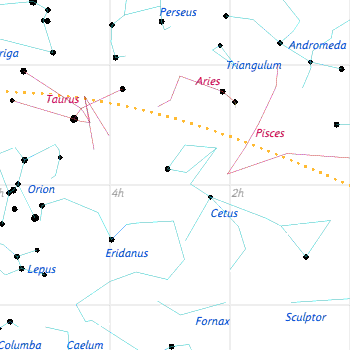Celestial Equator
|
Definition: [Ancient Astrological Concepts] An imaginary circle lying 90 º from both the North and South Celestial Poles. This circle is a projection of the Earth's equator into the night sky. It is not the same as the plane of the Ecliptic because - as shown in the diagram on the right - the Earth's axis of rotation is not exactly at right angles to the Ecliptic. This tilts the celestial equator to an angle of 23.45º to the Ecliptic. Further Information: As it's a projection of the Earth's equator into the night sky, it is therefore parallel to the east-to-west paths of the stars as they appear to wheel around the two celestial poles each night - an illusion cuased by the spin of the Earth itself. See Viewpoint for further information. Why is it an Equinox when the Sun is at a Crossing Points of the Ecliptic and the Celestial Equator? The Earth's axis is currently tilted so that it always points in one direction, roughly towars Polaris the northern pole star. In the course of one year, as the Earth orbits the Sun this means that the Earth's North Pole goes through two extremes. These are when it points 23.45º towards the Sun, the Winter Solstice in the Northern Hemisphere, or 23.45º towards the Sun [Summer Solstice, Northern Hemsiphere]. At the midpoints between the two - the Solstices - it neither points away from nor towards the Sun. On these Solstice dates if you stood on the Equator and looked straight up, the Sun would be directly above you at mid day. Hence the Equator and Sun are exactly aligned at that moment. This means that the Celestial Equator and the Ecliptic, as the path of the Sun have to be in alignment as well. How does the Celstial Equator Appear on a Star Map Our normal way of mapping the night skies is by reference the the Celestial Equator. The performs exactly the same function on star maps as the Erath's equator does on maps of the Earth. Hence, it appears as a horizontal line in the middle of maps of the stars. Declination: In the modern astronomical coordinate system, the celestial equator marks the 0 º declination line. Declination [given the Greek symbol delta] then increases to +90 º or decreases to - 90 º as you move your view up to the north or down to the south celestial pole. The pole star Polaris, therefore, has a declination of approximately +90 º. This declination system of describing the heavens is exactly the same as the latitude system for describing positions on the Earth. London lies at a latitude of 51 º North, for example; and the star Capella, in Auriga, has a declination of + 46 º. |
 © ©Celestial Equator Viewed from the Sun This would be how the Earth looked through a telescope if you were viewing it from the Sun on the day of an Equinox - if by magic you could see the plane of the Ecliptic [in yellow] and the great circle of the celestial equator [in red]. The Earth's axis is shown coming out of the south pole of the Earth. The plane of the Ecliptic lies between the Sun and the Earth [it's not too well drawn here - where it just seems to surround the Earth], but the Earth 's axis is tilted relative to this plane, and therefore so is the Earth's equator and therefeore the celestial equator.
If - magically - you could see the imaginary lines of the Ecliptic and the Celestial Equator, you would known this was the Equinox. The reason for this is that at the Solstice day and night are equal length. This only happens when the the celestial equator and the Ecliptic lie exactly in front of the Earth from the view point of the Sun.

Section of a Star Chart of the Ecliptic The celestial equator is the horizontal line in the centre of the star map. The far right edge of the map marks the line of the Vernal Equinox on the Celestial Sphere. |
© Dr Shepherd Simpson, Galactic Astrologer
The Galactic Astrologer
Do you want to know more about Galactic Astrology ?
Then enter the Galactic Zodiac
See the new Astrological Index for the meaning of other astrological words and phrases